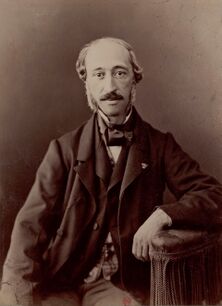إدمون بكرل
إدمون بكرل | |
|---|---|
Edmond Becquerel | |
 | |
| وُلِدَ | 24 مارس 1820 |
| توفي | 11 مايو 1891 (aged 71) |
| القومية | فرنسي |
| عـُرِف بـ | أول من رصد photovoltaic effect |
| الأنجال | هنري بكرل |
| الوالدان | أنطوان سيزر بكرل |
| السيرة العلمية | |
| المجالات | فيزياء |
ألكسندر-إدمون بكرل (Alexandre-Edmond Becquerel ؛ 24 مارس 1820 – 11 مايو 1891),[1] يشتهر بإسم إدمون بكرل، كان فيزيائياً فرنسيا درس الطيف الشمسي والمغناطيسية والكهرباء والبصريات. ويُنسب إليه فضل اكتشاف photovoltaic effect, the operating principle of the solar cell, in 1839.[2][3] He is also known for his work in luminescence and phosphorescence. He was the son of Antoine César Becquerel and the father of Henri Becquerel, one of the discoverers of radioactivity.
السيرة
Becquerel was born in Paris and was in turn the pupil, assistant and successor of his father at the Muséum national d'Histoire naturelle. He was also appointed professor at the short-lived Agronomic Institute at Versailles in 1849, and in 1853 received the chair of physics at the Conservatoire des Arts et Métiers. He was associated with his father in much of his work.
أول جهاز فوتوڤولتائي
In 1839, at age 19, experimenting in his father's laboratory, Becquerel created the world's first photovoltaic cell. In this experiment, silver chloride or silver bromide was used to coat the platinum electrodes; once the electrodes were illuminated, voltage and current were generated. Because of this work, the photovoltaic effect has also been known as the "Becquerel effect".
اكتشافات فوتوغرافية
Becquerel was an early experimenter in photography. In 1840, he discovered that the silver halides, natively insensitive to red and yellow light, became sensitive to that part of the spectrum in proportion to their exposure to blue, violet and ultraviolet light, allowing daguerreotypes and other photographic materials to be developed by bathing in strong red or yellow light rather than by chemical treatment.[4] In practice this technique was rarely used. In 1848 he produced color photographs of the solar spectrum, and also of camera images, by a technique later found to be akin to the Lippmann interference method, but the camera exposures required were impractically long and the images could not be stabilized, their colors persisting only if kept in total darkness,[5] however this work is based on the discoveries of J. T. Seebeck prior to 1810.[6]
دراسات أخرى
Becquerel paid special attention to the study of light, investigating the photochemical effects and spectroscopic characters of solar radiation and the electric arch light, and the phenomena of phosphorescence, particularly as displayed by the sulfides and by compounds of uranium. It was in connection with these latter inquiries that he devised his phosphoroscope, an apparatus which enabled the interval between exposure to the source of light and observation of the resulting effects to be varied at will and accurately measured.
He investigated the diamagnetic and paramagnetic properties of substances and was keenly interested in the phenomena of electrochemical decomposition, accumulating much evidence in favor of Faraday's law of electrolysis and proposing a modified statement of it which was intended to cover certain apparent exceptions. In 1853, Becquerel discovered thermionic emission.
منشورات
In 1867 and 1868 Becquerel published La lumière, ses causes et ses effets (Light, its Causes and Effects), a two-volume treatise which became a standard text. His many papers and commentaries appeared in French scientific journals, mainly the French Academy of Science's widely distributed Comptes Rendus, from 1839 until shortly before his death in 1891.
التكريم والجوائز
Becquerel was elected a member of the Royal Swedish Academy of Sciences in 1886.
The Becquerel Prize for "outstanding merit in photovoltaics" is awarded annually at the European Photovoltaic Solar Energy Conference and Exhibition (EU PVSEC).
انظر أيضاً
المراجع
- ^ "Molecular Expressions: Science, Optics and You - Timeline - Alexandre Edmond Becquerel". micro.magnet.fsu.edu. Retrieved 2021-12-11.
- ^ R. Williams (1960). "Becquerel Photovoltaic Effect in Binary Compounds". The Journal of Chemical Physics. 32 (5): 1505–1514. Bibcode:1960JChPh..32.1505W. doi:10.1063/1.1730950.
- ^ E. Becquerel (1839). "Mémoire sur les effets électriques produits sous l'influence des rayons solaires". Comptes Rendus. 9: 561–567.
- ^ E. Becquerel (1840). "Mémoire sur le rayonnement chimique qui accompagne la lumière solaire et la lumière électrique", Comptes Rendus 11:702–703.
- ^ E. Becquerel (1848). "L'image photographique colorée du spectre solaire", Comptes Rendus 26:181–183.
- ^ Wall, E. J. (Edward John) (1922). Practical color photography. Getty Research Institute. Boston, Mass., American Photographic Publishing Co. p. 200.
للاستزادة
- A. Allisy (1 November 1996). "Henri Becquerel: The Discovery of Radioactivity". Radiation Protection Dosimetry. 68 (1): 3–10. doi:10.1093/oxfordjournals.rpd.a031848.
 Chisholm, Hugh, ed. (1911). . دائرة المعارف البريطانية. Vol. 3 (eleventh ed.). Cambridge University Press.
Chisholm, Hugh, ed. (1911). . دائرة المعارف البريطانية. Vol. 3 (eleventh ed.). Cambridge University Press. {{cite encyclopedia}}: Cite has empty unknown parameter:|coauthors=(help)